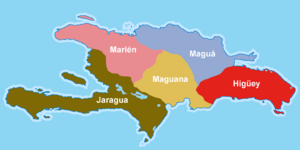Caonabo facts for kids
Quick facts for kids Caonabo |
|
|---|---|
| Cacique of Maguana | |
| Reign | ?–1496 |
| Born | Lucayan Archipelago |
| Died | 1496 |
| Spouse | Anacaona |
Caonabo (died 1496) was a powerful Taíno leader, also known as a cacique (pronounced kah-SEE-kay). He lived on the island of Hispaniola when Christopher Columbus first arrived. Caonabo was famous for his bravery and fighting skills. He was married to Anacaona, who was also a very important leader and the sister of another cacique named Bohechío.
Caonabo led attacks against the Spanish because they treated the Taíno people badly. He even attacked a Spanish fort called La Navidad, where 39 Spanish soldiers died. His capture in 1494 led to the first big uprising by Native Americans against Spanish rule. Caonabo died while he was a prisoner of the Spanish.
Who Was Caonabo?

Caonabo was one of the most important caciques on Hispaniola when Christopher Columbus arrived. The island was divided into five main areas, each ruled by a cacique. Caonabo ruled the chiefdom of Maguana, in the southern part of the island. Today, this area is near San Juan de la Maguana in the Dominican Republic.
His wife, Anacaona, was the sister of Bohechío. Bohechío was another strong cacique who ruled the nearby area of Jaragua. Caonabo was not originally from Hispaniola. He was born in the Lucayan Archipelago, which is now part of the Bahamas.
A Spanish historian named Bartolomé de las Casas wrote about Caonabo. He said that Caonabo was a very brave and strong leader. He had a lot of respect and authority. People who first came to the island believed he was from the Lucayan Islands. He became king of his area because he was a great leader in both war and peace. Everyone thought highly of him.
Fighting the Spanish Explorers
In 1492, Columbus tried to land on the north coast of Hispaniola. But he was attacked by arrows and had to leave. He eventually landed on the south coast, where the city of Santo Domingo is now. Columbus's ship, the Santa María, crashed on the north coast. Columbus used parts of the wrecked ship to build a fort. Because the shipwreck happened on Christmas Day, the fort was called La Navidad (which means "Christmas" in Spanish).
Columbus left some of his crew at La Navidad and went back to Spain. He thought his men would be safe and that the native people were friendly. But Caonabo led an attack on the fort in 1493. All the Spanish soldiers left there were defeated. Caonabo's wife, Anacaona, later explained why. She said she encouraged Caonabo to take back the village because the Spanish were treating the native people badly.
When Columbus returned to Hispaniola, he found La Navidad destroyed. Caonabo quickly became known as one of the strongest leaders on the island. Another cacique, Guacanagaríx, told the Spanish that Caonabo was responsible for the attack. In 1494, Bartholomew Columbus heard that Caonabo was planning to attack another Spanish fort. This fort was called Santo Tomás. To scare the native people and make them obey, Columbus sent 400 men. They were led by Alonso de Ojeda and marched into the island's center.
Caonabo's Capture and Death
Soon after, Caonabo was captured by Ojeda and became a prisoner. There are different stories about how he was captured. Some historians believe the Spanish made the story sound more exciting.
Bartolomé de las Casas wrote that Ojeda tricked Caonabo. Ojeda brought shiny handcuffs and chains. He told Caonabo they were a special gift. Ojeda supposedly convinced Caonabo that these items had magic powers. He said that kings in Spain wore them. When Caonabo tried on the handcuffs, Ojeda locked them. This is how he took Caonabo prisoner.
Caonabo's capture made the Taíno people very angry. This led to the first big uprising by Native Americans against the Spanish. Caonabo's brother, Manicatex, gathered about 7,000 native people. They planned to attack the Spanish and free Caonabo. However, the Taíno were easily defeated. This was mainly because the Spanish used cavalry (soldiers on horseback). Manicatex and other native leaders were also taken prisoner.
The Spanish decided to send Caonabo away from the island. They wanted to stop any more uprisings. So, Caonabo and his brother were sent to Spain by ship. Caonabo died during the long journey. He was buried at sea.
See also
Template:Kids robot.svg In Spanish: Caonabo para niños

